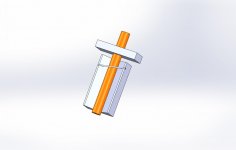RJT
Titanium
- Joined
- Aug 24, 2006
- Location
- greensboro,northcarolina
Being asked to quote internal Acme threaded parts 5/8 -8 2GLH by 4.75 deep. Material is 17-4 stainless, customer will supply gages. We have a Mits EX8 CNC sinker, probably have to burn it sideways (too tall) . I'm thinking I would need multiple electrodes for each piece and trying to conceptualize how to time each electrode so we don't "cross thread". I can buy orbiting tapping electrodes, we burn threads all the time, but much smaller and never done an Acme. Never had to use more than 1 electrode per piece (just orbit to size), so this has never come up. I don't mind a challenge, but this one has me scratching my head.


